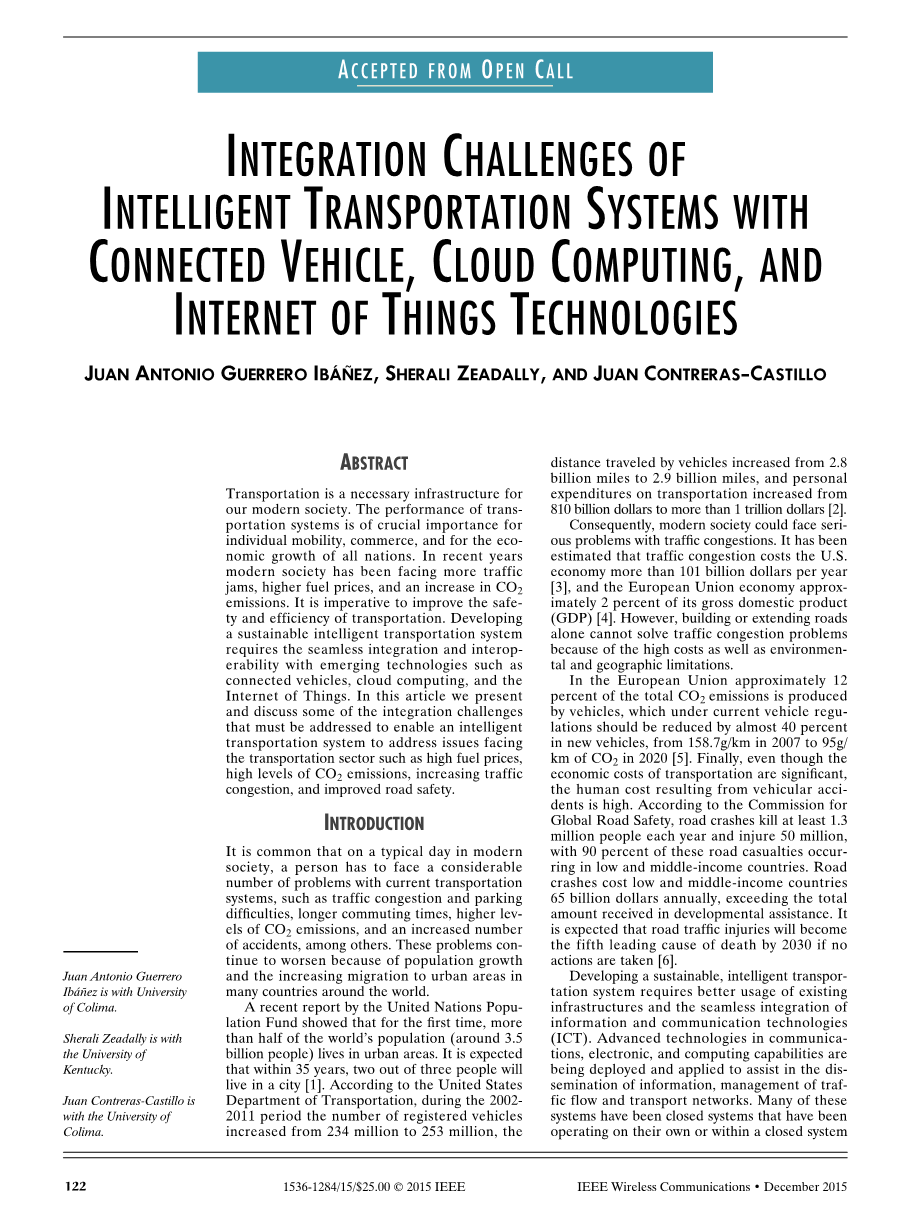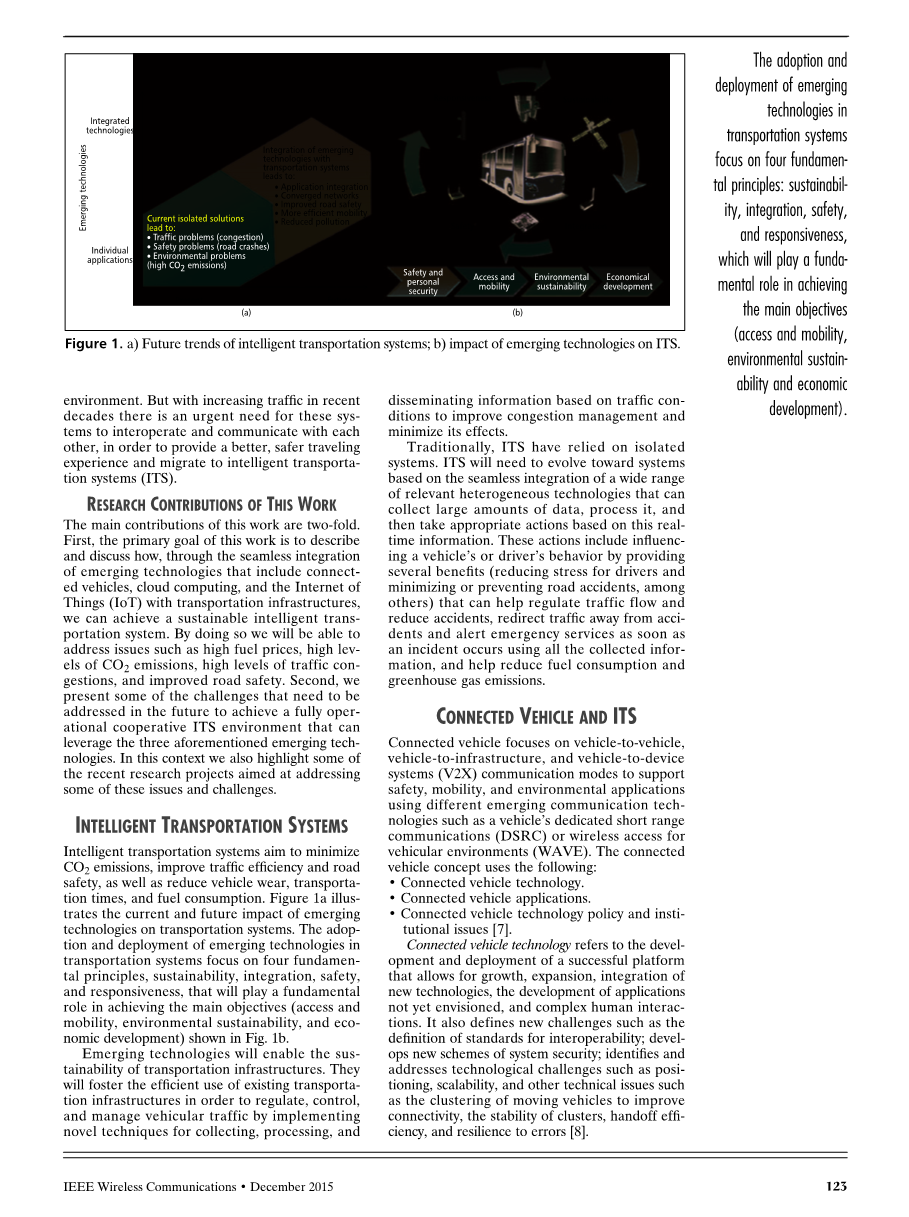

英语原文共 7 页,剩余内容已隐藏,支付完成后下载完整资料
原文
IntegrAtIon chAllenges of IntellIgenttrAnsportAtIon systems wIth connected VehIcle, cloud computIng, And Internet of thIngs technologIes
Juan antonio Guerrero ibaacute;ntilde;ez, Sherali zeadally, and Juan ContreraS-CaStillo
AbstrAct
Transportation is a necessary infrastructure for our modern society. The performance of transportation systems is of crucial importance for individual mobility, commerce, and for the economic growth of all nations. In recent years modern society has been facing more traffic jams, higher fuel prices, and an increase in CO2 emissions. It is imperative to improve the safety and efficiency of transportation. Developing a sustainable intelligent transportation system requires the seamless integration and interoperability with emerging technologies such as connected vehicles, cloud computing, and the Internet of Things. In this article we present and discuss some of the integration challenges that must be addressed to enable an intelligent transportation system to address issues facing the transportation sector such as high fuel prices, high levels of CO2 emissions, increasing traffic congestion, and improved road safety.
IntroductIon
It is common that on a typical day in modern society, a person has to face a considerable number of problems with current transportation systems, such as traffic congestion and parking difficulties, longer commuting times, higher levels of CO2 emissions, and an increased number of accidents, among others. These problems continue to worsen because of population growth and the increasing migration to urban areas in many countries around the world.
A recent report by the United Nations Population Fund showed that for the first time, more than half of the worldrsquo;s population (around 3.5 billion people) lives in urban areas. It is expected that within 35 years, two out of three people will live in a city [1]. According to the United States Department of Transportation, during the 20022011 period the number of registered vehicles increased from 234 million to 253 million, the distance traveled by vehicles increased from 2.8 billion miles to 2.9 billion miles, and personal expenditures on transportation increased from 810 billion dollars to more than 1 trillion dollars [2].
Consequently, modern society could face serious problems with traffic congestions. It has been estimated that traffic congestion costs the U.S. economy more than 101 billion dollars per year [3], and the European Union economy approximately 2 percent of its gross domestic product (GDP) [4]. However, building or extending roads alone cannot solve traffic congestion problems because of the high costs as well as environmental and geographic limitations.
In the European Union approximately 12 percent of the total CO2 emissions is produced by vehicles, which under current vehicle regulations should be reduced by almost 40 percent in new vehicles, from 158.7g/km in 2007 to 95g/ km of CO2 in 2020 [5]. Finally, even though the economic costs of transportation are significant, the human cost resulting from vehicular accidents is high. According to the Commission for Global Road Safety, road crashes kill at least 1.3 million people each year and injure 50 million, with 90 percent of these road casualties occurring in low and middle-income countries. Road crashes cost low and middle-income countries 65 billion dollars annually, exceeding the total amount received in developmental assistance. It is expected that road traffic injuries will become the fifth leading cause of death by 2030 if no actions are taken [6].
Developing a sustainable, intelligent transportation system requires better usage of existing infrastructures and the seamless integration of information and communication technologies (ICT). Advanced technologies in communications, electronic, and computing capabilities are being deployed and applied to assist in the dissemination of information, management of traffic flow and transport networks. Many of these systems have been closed systems that have been operating on their own or within a closed system
Figure 1. a) Future trends of intelligent transportation systems; b) impact of emerging technologies on ITS.
The adoption and deployment of emerging technologies in transportation systems focus on four fundamental principles: sustainability, integration, safety, and responsiveness, which will play a fundamental role in achieving the main objectives (access and mobility, environmental sustainability and economic development). environment. But with increasing traffic in recent decades there is an urgent need for these systems to interoperate and communicate with each other, in order to provide a better, safer traveling experience and migrate to intelligent transportation systems (ITS). reseArch contrIbutIons of thIs Work The main contributions of this work are two-fold. First, the primary goal of this work is to describe and discuss how, through the seamless integration of emerging technologies that include connected vehicles, cloud computing, and the Internet of Things (IoT) with transportation infrastructures, we can achieve a sustainable intelligent transportation system. By doing so we will be able to address issues such as high fuel prices, high levels of CO2 emissions, high levels of traffic congestions, and improved road safety. Second, we present some of the challenges that need to be addressed in the future to achieve a fully operational cooperative ITS environment that can leverage the three aforementioned emerging technologies. In this context we also highlight some
全文共50226字,剩余内容已隐藏,支付完成后下载完整资料
资料编号:[957]


